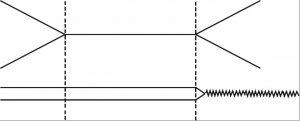American English Phonetics
Another American English Faculty Project
9.2 Aspiration
When we compare the stops in GA ski and key we can hear a short puff of air immediately after the release of /k/ in key, which is usually absent from that in ski. The same contrast can be observed in pairs like pie versus spy and till versus still.
ski – /skiː/
key – /kiː/
pie – /paɪ/
spy – /spaɪ/
till – /tɪl/
still – /stɪl/
The difference between the stops in these pairs lies in the beginning of vocal cord vibration (known as the ‘voice onset’). In ski, the voice onset coincides with the release of the stop, but in key, there is a delay. This causes the first portion of the vowel /iː/ to be devoiced, which as a result causes us to hear an h-like sound after the stop. This process, which is called aspiration, is symbolized by means of a superscript h, as in [kʰi:] or, phonetically more accurately, by means of a devoiced vowel, as in [ki̥i:], which is meant to indicate that the first portion of the vowel is whispered and the second voiced.
Although aspirated stops – with a considerably shorter voice delay – occur in many accents spoken in the East and North of the country (Twente, Groningen), in Standard Dutch, /p,t,k/ are unaspirated.
The effect of aspiration can be demonstrated by placing a lighted match about an inch away from the lips of a native speaker – careful now! – and asking them to say a word like pin. With luck, the flame should be blown out by the puff of breath that accompanies the aspirated [pʰ] in pin but much less so, if at all, when the word spin is pronounced.
The figures below illustrate the difference in the voice onset for aspirated and unaspirated stops. The parallel lines represent an open glottis, the wavy line a vibrating glottis.


